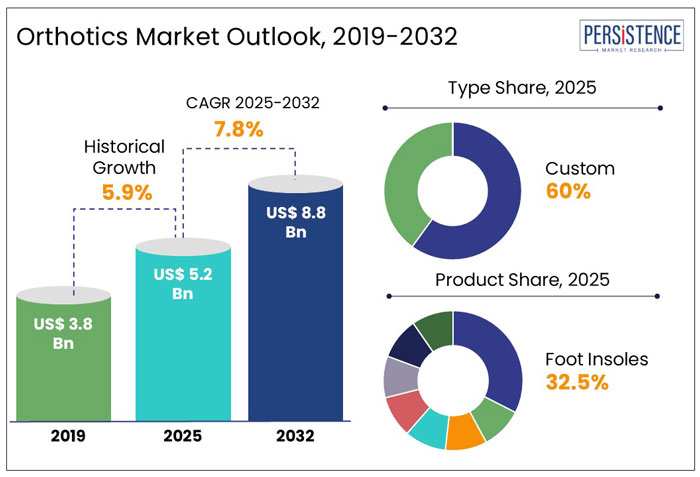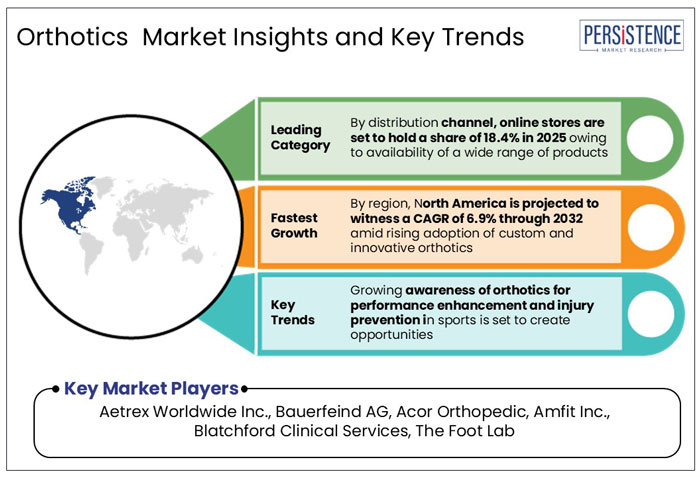Industry: Healthcare
Published Date: February-2025
Format: PPT*, PDF, EXCEL
Delivery Timelines: Contact Sales
Number of Pages: 182
Report ID: PMRREP33346
The global orthotics market is projected to witness a CAGR of 7.8% during the forecast period from 2025 to 2032. It is anticipated to increase from US$ 4.9 Bn in 2025 to a decent US$ 8.8 Bn by 2032.
The design and usage of orthosis are in high focus. Their ability to correct foot abnormalities, improve foot or ankle function, support the ankle, and lower the risk of further injuries have made them immensely popular among doctors globally. Rising prevalence of foot pain, especially among athletes and soldiers owing to frequent training regimens and load-bearing activities is set to propel orthotics demand.

Key Highlights of the Orthotics Market
|
Global Market Attributes |
Key Insights |
|
Orthotics Market Size (2025E) |
US$ 5.2 Bn |
|
Market Value Forecast (2032F) |
US$ 8.8 Bn |
|
Projected Growth (CAGR 2025 to 2032) |
7.8% |
|
Historical Market Growth (CAGR 2019 to 2024) |
5.9% |
Increasing Life Expectancy and Lifestyle Disorders Contributed to Growth from 2019 to 2024
The market for orthotics grew at a CAGR of 5.9% from 2019 to 2024, mainly due to surging incidence of osteoarthritis, osteoporosis, osteosarcoma. The global market is also developing rapidly due to factors such as rising life expectancy, increasing lifestyle-related disorders, and growing prevalence of different types of arthritis.
Global Initiatives and Awareness Campaigns to Boost Access to Orthotic Solutions through 2032
The global market for orthotics is likely to evolve at a CAGR of 7.8% during the forecast period from 2025 to 2032. It is mainly attributed to rising healthcare awareness and increasing prevalence of orthopedic conditions. For example,
Orthotic devices are essential for managing musculoskeletal disorders, improving mobility, and reducing pain. Technological innovations, including 3D printing are revolutionizing the development of personalized orthotic solutions tailored to individual patient needs. These developments are enhancing user comfort, improving treatment outcomes, and bolstering market growth.
Growth Drivers
Rising Cases of Orthopedic Conditions to Spur Demand for Pain Relief and Mobility Solutions
The global orthotics market is witnessing significant growth due to various key factors. A leading contributor is the rising prevalence of orthopedic conditions that require orthotics for pain relief, enhanced mobility, and prevention of further complications.
Increasing incidence of sports injuries and accidents also plays a vital role in bolstering the market. Furthermore, rising public awareness about the preventive and pain management benefits of orthotics is augmenting their adoption. For example,
Technological developments, including personalized fitting solutions, are enabling the launch of more innovative and effective orthotics tailored to diverse patient needs. Additionally, growing affordability of orthotics and easier accessibility through e-commerce platforms are propelling market expansion.
Concerns Over Potential Negative Effects to Prevent Wider Adoption of Orthotic Products
When it comes to orthotics, people usually purchase related products to alleviate foot pain, ankle discomfort, and other lower body problems. Potential negative effects, though, are one reason that prevents some people from utilizing them. The possibility of these products making a problem worse can be quite deterring whether a potential user has heard it from another wearer or has personally experienced it.
While they should lessen foot pain, orthosis occasionally can make the condition worse by making the feet work harder because of the support they provide that is not natural. Insoles that only offer minimal support can also modify the body’s mechanics and cause postural alterations, which can make a person more susceptible to injury.
Even if mass-produced insoles do relieve foot pain, doing so may occasionally come at the expense of added pressure on the knees, hips, and other areas of the body. Rising cost of custom devices is another hindrance to the market. For example,
Even though custom devices offer several advantages over those that are mass-produced, many people still opt for them. Prefabricated medical devices used nowadays are highly complex and come in a variety of shapes and sizes to treat various types of illnesses and ailments. The high prices of these devices are the main hindrance to market growth.
Athlete and Influencer Collaborations to Push Market Penetration for Orthotic Solutions
The orthotics market offers various opportunities that can influence its future growth and development. One key area is the rising focus on personalized, patient-centric care, which paves the way for innovative custom orthotic solutions utilizing developments such as 3D printing and digital technologies.
The trend toward customization addresses the high demand for orthotic devices that are not only comfortable and effective but also visually appealing, helping businesses stand out in the market. Additionally, use of orthotics is surging beyond traditional rehabilitation, finding new applications in areas like sports performance enhancement, preventive care, and chronic disease management.
Integration of novel technologies, including smart sensors, artificial intelligence, and telehealth platforms, further enhances the functionality of orthotics. These are enabling improved monitoring and remote patient care while fostering better patient engagement and outcomes. A few companies are also focusing on collaborating with athletes and social media influencers to attract new customers. For example,
Type Insights
Rising Demand for Personalized Healthcare to Push Growth in the Custom Orthotics Segment
By type, custom orthotics are estimated to hold a share of 60% in 2025. It is due to their superior ability to meet individual patient needs. These devices are tailored based on precise foot measurements and medical conditions, offering enhanced comfort, support, and effectiveness compared to prefabricated options.
Growing demand for personalized healthcare solutions, developments in 3D printing, and digital scanning technologies are further augmenting adoption of custom orthotics. These are particularly favored in managing complex orthopedic conditions, sports injuries, and chronic pain. As healthcare professionals prioritize individualized care, the custom orthotics segment continues to lead and shape market trends globally. For instance,
Product Insights
Innovations in Materials and Ergonomic Designs to Improve Effectiveness and Wearability of Insoles
By product, the foot insoles segment is projected to hold a share of 32.5% in 2025. There is a growing recognition of the importance of foot health and the role insoles play in preventing and alleviating discomfort. Individuals are becoming more proactive in seeking solutions to maintain foot comfort and prevent injuries. A significant portion of the population experiences foot pain or related conditions.
Innovations in materials and design have led to more effective and comfortable insoles. For example, the integration of 3D printing technology allows for the creation of custom orthotic insoles tailored to individual foot structures, enhancing comfort and support.

Rising Prevalence of Musculoskeletal Disorders to Augment Orthotic Demand in North America
North America orthotics market is projected to hold a share of 40% in 2025 and witness a CAGR of 6.9% through 2032. It is driven by a well-established healthcare infrastructure, high healthcare expenditure, and a strong focus on technological developments.
The region's leadership is further fueled by increasing prevalence of musculoskeletal disorders, diabetes, and arthritis, which significantly propel demand for orthotic solutions. Additionally, rising adoption of custom and innovative orthotics, supported by developments like digital scanning contributes to market growth.
The U.S., being a key contributor, benefits from a large base of leading market players, robust insurance coverage for orthotic devices, and growing public awareness of the benefits of orthotics in preventive and therapeutic care. For example,
Rising Sports-related Injuries to Boost Adoption of Foot Orthotic Insoles for Recovery and Prevention in Europe
Europe orthotics market is estimated to hold a share of 28.2% in 2025. One prominent contributor to growth is the increasing participation in sports and athletic activities across the continent.
As more individuals engage in physical exercise, there is a corresponding rise in sports-related injuries and a surging focus on performance optimization, leading to greater utilization of orthotic solutions. This trend is supported by data indicating a high demand from the sports and athletics sector for foot orthotic insoles. For example,
Geriatric Population with Mobility Issues to Seek Innovative Solutions in Asia Pacific
The orthotics market in Asia Pacific will likely surge at a CAGR of 6.3% from 2025 to 2032. A significant contributor to growth is the region's rapidly aging population.
As the population ages, there is an increased prevalence of musculoskeletal disorders and mobility challenges, leading to a high demand for orthotic solutions to enhance mobility and quality of life. Rising incidence of chronic conditions such as diabetes and osteoarthritis in the region has also augmented the need for orthotic devices.
The competitive landscape of the orthotics and prosthetics market is multifaceted, featuring a blend of established leaders, innovative start-ups, and technology-driven entities all vying for prominence. Leading companies boast expansive product portfolios, global reach, and brand equity.
Concurrently, a wave of emerging players and start-ups are making differences by specializing in niche segments, leveraging disruptive technologies like 3D printing and wearable sensors to introduce personalized and smart orthotic solutions. Strategic partnerships and collaborations are increasingly prevalent, enabling knowledge exchange, research endeavors, and market growth.
As companies navigate this competitive terrain, a customer-centric ethos is paramount, bolstering investments in patient education, healthcare professional training, and tailored orthotic offerings. Additionally, regulatory compliance remains a cornerstone, necessitating adherence to evolving standards and healthcare reforms across diverse regions. Collectively, these dynamics shape a competitive orthotics landscape characterized by innovation, strategic alliances, customer focus, and regulatory diligence.
Recent Industry Developments
|
Attributes |
Details |
|
Historical Data/Actuals |
2019 to 2024 |
|
Forecast Period |
2025 to 2032 |
|
Market Analysis Units |
Value: US$ Bn/Mn, Volume: As applicable |
|
Geographical Coverage |
|
|
Segmental Coverage |
|
|
Competitive Analysis |
|
|
Report Highlights |
|
|
Customization & Pricing |
Available upon request |
By Product
By Application
By Type
By Distribution Channel
By Region
To know more about delivery timeline for this report Contact Sales

Yes, the market is set to reach US$ 8.8 Bn by 2032.
North America is set to witness a high market share in 2025.
Aetrex Worldwide Inc., Bauerfeind AG, Acor Orthopedic, and Amfit Inc. are considered the leading players.
The global orthotics industry is projected to witness 7.8% CAGR through 2032.
More than 50% of the patient population suffering from foot pain are using orthodontic insoles.